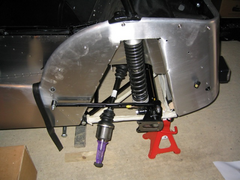

Rescued attachment Picture 016.jpg

on the de dion axle can you have the top 2 bars shorter then the bottom. and for the fixing points what would be the best adjustment for them. to move
the top bars up and down or or the bottom
adam
If they are different lengths they will rotate the de dion slightly, I don't know what the effect of that will be, probably nothing if the wheels
are perfectly straight and the bushes on everything are flexible enough. I don't see why you would want to move the bars (trailing arms?) up or
down.
[Edited on 19/6/07 by Peteff]
Simple answer is no, they need to be the same length.
and parallel!!!
quote:
Originally posted by JonBowden
Simple answer is no, they need to be the same length.
Exactly, all the above.
The implication of de dion, while unsaid, is that it's so much simpler to build (mechanically) that it requires no thought and anyone can do it.
Yes, it's simpler, but anyone thinking they can turn the brain off is in for a rude surprise. De Dion doesn't get the builder out of the
responsibility of knowing what's going on, and it's good to have these discussions.
Although if you look at a Caterham, the A-frame is much shorter than the trailing arms.


Rescued attachment Picture 016.jpg
Caterham is a 4 link
Locost/Westie is 5 link
4 link gives perfect restraint in all the required axis.
In a 5 link set up is over restrained, it has one link too many unless it is dimensionally perfect it can put very large loads into the chassis
The diff is fastened to the chassis, it doesn't move with the de dion axle. The CV joints on the drive shafts will cope with any movement you throw at them as long as it's not too far out of their operational range.
The issue is that if the links aren't parallel to the ground at normal ride height, it's very easy to end up with toe-out in bump. What I
was referring to above is that I only hear about toe-out in bump being associated with IRS. It's just as easy to have the same problem with
trailing links.
The links also need to be the same length. As said above, what happens is that when cornering, one side goes into bump while the other side goes into
droop. The problem is one side's trying to rotate the axle housing clockwise, while the othersides trying to rotate it counterclockwise. The end
result is binding, and a rear suspension that is far stiffer than intended, resulting in oversteer and spins. [As noted, this is only true for live
axle, not de dion, though the comments above about toe still apply.]
[Edited on 6/21/07 by kb58]
quote:
Originally posted by Peteff
The diff is fastened to the chassis, it doesn't move with the de dion axle.
 I was of course referring to the live axle which the OP doesn't have
I was of course referring to the live axle which the OP doesn't have 
iam asking because ive read on a few sites that if you move the top two bars down you get anti squat so you get more power down. but i want to make
it so i can adjust it so i can play with it so suit my driveing. foot on floor red line lol
adam
quote:
Originally posted by oadamo
iam asking because ive read on a few sites that if you move the top two bars down you get anti squat so you get more power down. but i want to make it so i can adjust it so i can play with it so suit my driveing. foot on floor red line lol
adam
The anti squat works from the torque reaction of the axle, so with a live axle when the front of the diff wants to lift (gear climbing the pinion) the
top arm tries to go parrallel (furthest distance) and so pushes the axle down to the ground.
With a dedion the torque reaction isn't there.. so no point, this is where dedion is great, it doesn't try to rotate the axle, and it
doesn't try to lift one end of the axle as the diff is fixed, team this up with inboard brakes, it removes torque reaction from braking.
I take it the original poster is wanting to set up a satchel link, where the angle top arms (when viewed from above) locate the axle laterally aswell,
best off with 4 parallel links and a panhard/watts/mumford for lateral location. I'd only use shorter top arms on a live axle and if I'd
made the bottom arms longer than they are.